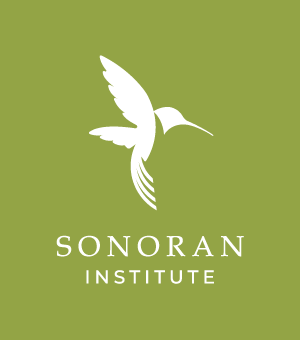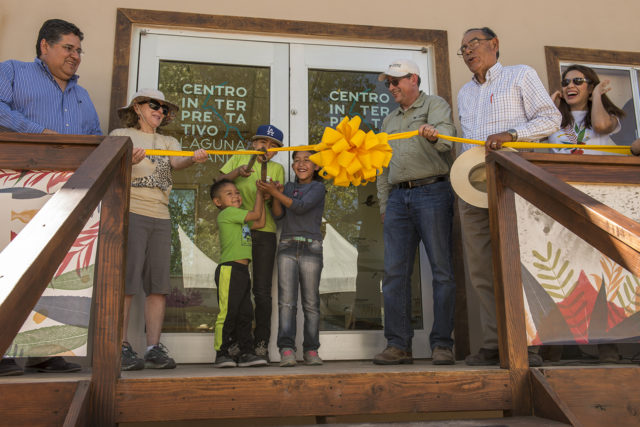
Collaboration made it possible
Have you ever seen how an ant colony moves at full-speed around their hill? They might look frantic and confused but also completely unstoppable? That was us, the Sonoran Institute staff, on the day before the Laguna Grande Interpretive Center Grand Opening. We looked like we were running around but we knew that our goal was set: welcoming more than 100 guests to our restoration site and making sure they would enjoy an activity filled day in the forest, by the river.
A little less than ten years ago, the idea of restoring this land and river was just a dream for a few people. Back then, Laguna Grande was barren and covered with salt cedar, an invasive species, but is now recognized as the largest stand of cottonwoods along the Colorado River in Mexico. Hundreds of bird species have come back to the forest to nest and live; beaver, coyote and bobcats call Laguna Grande home again. The dream is materializing.
When we walk on the trails, barn owls watch us from high up in the towering cottonwoods, and cicadas adorn the forest with their summer songs. The forest in Laguna Grande has provided a place for adventure, learning and exploration for the communities that rely on the river. About 3,000 school children and families visit throughout the year and for special Family Saturdays, and hundreds of volunteers have joined us each year for tree planting events, but we were still missing something.
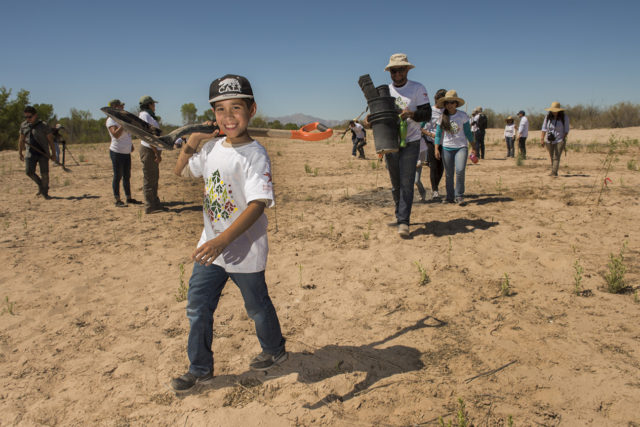
As a non-profit organization, Sonoran Institute relies on support from foundations and donors to carry out our mission of connecting people to the natural resources that nourish and sustain them. We believe that generosity counts, no matter what shape it takes, and we recognize that sometimes a gift can be much more creative than pesos or dollars. A very generous man from the Mexicali Valley donated something quite unique—an old trailer, just a little house, semi-portable, and a little out of shape. But, for us this gift represented a transformation. We knew it would become just the thing we needed to support our restoration efforts. That’s because the Laguna Grande site never had an “indoors” at all. We did not yet have a place to showcase the changes we’ve made, a place to display our story and photos, a place to get out of the weather, which is often hot, or too cold.
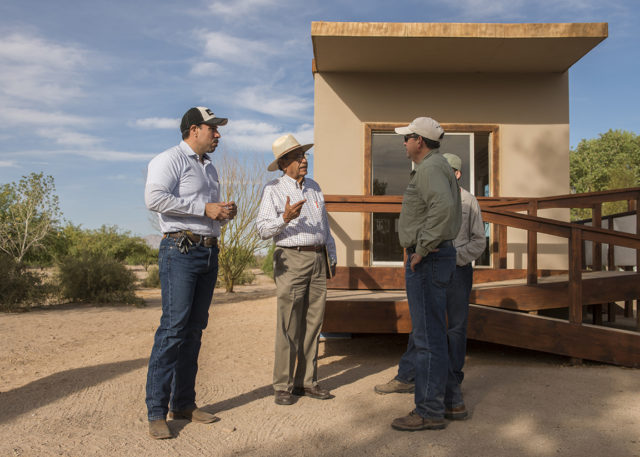
The environmental education and communication teams spent more than a year planning how to use this blank canvas measuring, 4 x 10-square meters, to build a welcoming place with exhibits and stories where the community can learn about the Colorado River—why it nearly disappeared, how it has changed over time, how we are bringing it back, and about the communities who call the Delta home. It is also a good place to learn about how to get involved and contribute to the restoration.
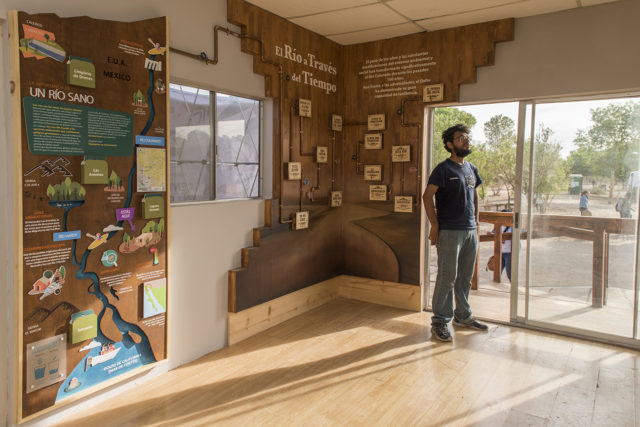
Researching, gathering, curating information and getting our brains fired up to design something to match the surroundings was a big undertaking. Through collaboration, this little trailer home is now completely unrecognizable as such—it is an interpretive center set by one of the original Colorado River meanders, waterfront porch and all.
After all the planning and designing we jumped into installing our center, and did we ever hit a challenge! We could not have anticipated how hard it would be to place the structure perfectly. We had a crew of workers, we had heavy machinery, we had experts and muscle, but we were little match for the very, very sandy bank. The tractor would tow so slowly and carefully, but each time the base would be just a little too crooked. Each maneuver added stress to the trailer. And after many attempts, we discovered it was too much. We faced cracked walls and fallen doors when we finally got it right. These setbacks would take time to fix—but we rejoiced because it could all be fixed! We could get it done! After a little rehab to the structure, the construction and mounting of the inside panels was easy enough. Just like a puzzle, piece-by-piece, what once was only on paper and in our imaginations, was coming to life.
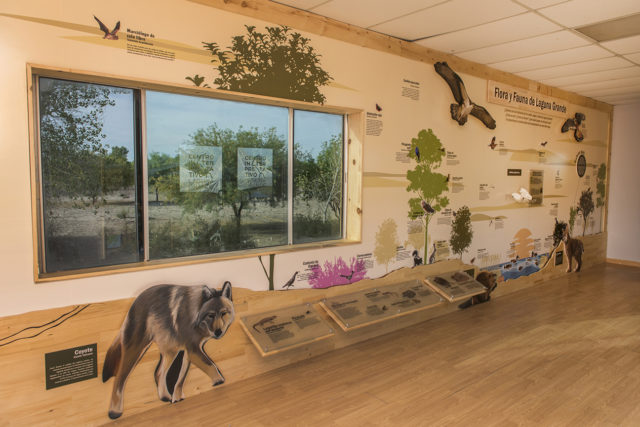
For over three years, Sonoran Institutes’ education program has offered interpretive tours for schools or families. Tours include bird watching, hiking under a canopy of cottonwood and willow trees, exploring a labyrinth of mesquites and, if you’re lucky, kayaking on the river. Now the tours can begin in the Laguna Grande Interpretive Center with a proper introduction because on April, 6th, 2018 the doors of the Laguna Grande Interpretive Center finally opened in an event held for our closest partners, supporters, staff, families and community.
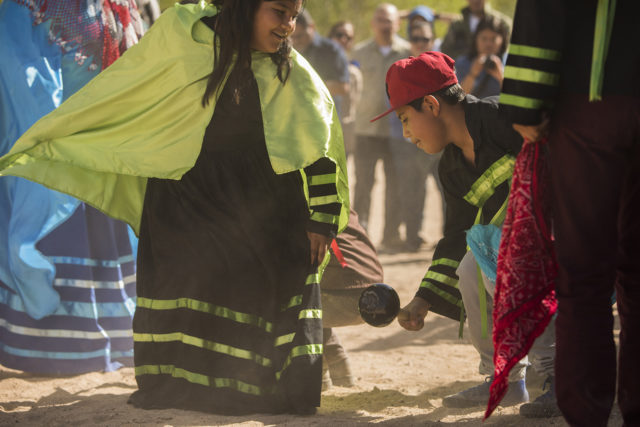
As we gathered, the native Cucapah tribe offered song and dance, and a blessing that almost made it seem as though time stopped for a moment. I felt that this was the beginning of something bigger—the beginning of a new relationship between the people and the river.
We would continue to create a better future for the Colorado River Delta by holding our annual native tree-planting event the day after the opening. With shovels in hand and ready to brave the sun, more than 100 volunteers joined us by the river in the early morning on Saturday, April 7th. Together we planted 1,200 cottonwoods, mesquites, willows and other shrub species that are still growing high and strong. Restoring the Delta does not only depend on the scientists, restoration experts and staff, we also need to engage the local communities to ensure the sustainability of the project.
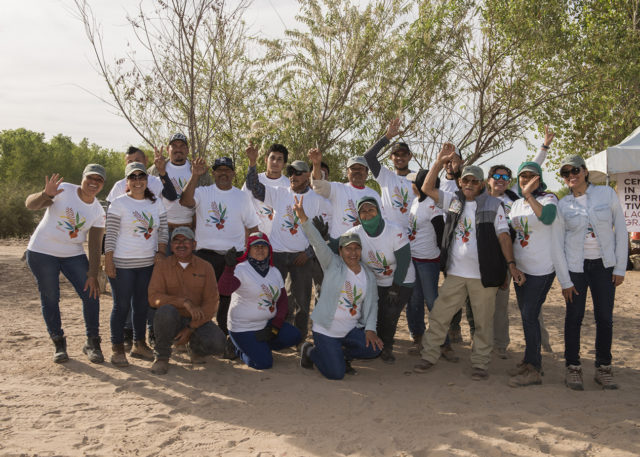
Planting a tree is more than just digging a hole and placing a sapling into it. Planting a tree in the Delta means mending the errors of the past, rebuilding our sense of place, and building a future for our community.
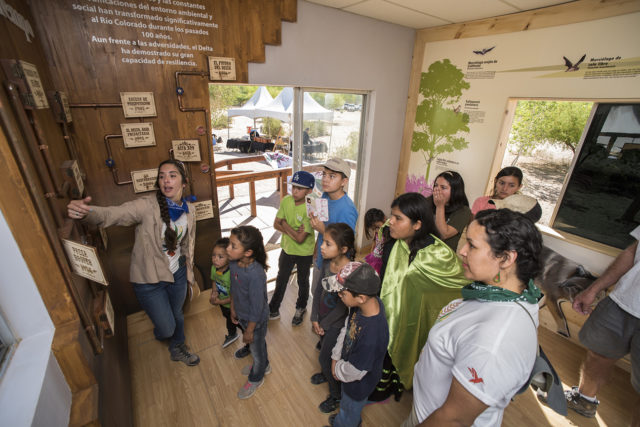
Sonoran Institute has spent more than 25 years helping communities adapt to changing environmental and economic conditions. When you join us, you become part of the solution and you send a loud and positive message: we are together in this. Everything is better with community, despite the obstacles, because a sustainable future is possible. You can help Sonoran Institute by becoming a monthly donor, donating equipment and tools, volunteering at our events or with your expertise. And, you can also visit! There are various ways to visit our restoration sites and the Laguna Grande Interpretive Center.
Send an email to Gabriela González for more information about our education program.
Together We Thrive! we hope you’ll contribute what you can by making a donation today.
Blog Post By: Gabriela González Olimón, Environmental Education and Investigation Coordinator
